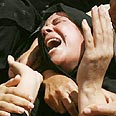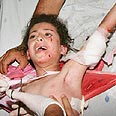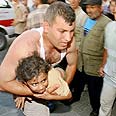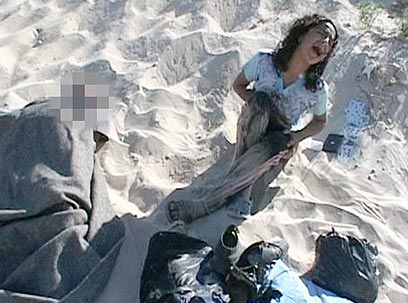


The British Guardian and Independent newspapers on Saturday published independent investigations which cast a doubt on the IDF's version. According to the reporters, the key point is the army's claim that the shelling of the area was halted nine minutes before the seven family members were killed.
This claim is not in line with testimonies given by survivors and medical personnel who attended to the injured.
In addition to these findings, the Times reported that the IDF admitted to the newspaper's reporter that its official account of the explosion was flawed. According to the report, the army failed to mention two shells fired from navy boats at around the times of the deaths. The two shells hit the beach between 4:24 p.m. and 4:55 p.m.
The IDF Spokesperson's Office firmly denied the report.
"We regret the fact that such a serious and important newspaper chooses to publish such a distorted and false headline instead of sticking to the facts presented to them in detail with the head of the investigative team, Major-General Meir Kalifi. The IDF's Spokesperson's Office stresses once again that the IDF is not responsible for hurting the Ghalia family," an official said.
Blast occurred during shelling
The Times also reported that at 4:43 p.m., the United Nations received a radio call from one of its officials in northern Gaza that said: “At 16:33hrs IDF artillery shelling has started again targeting the northern area, two artillery shells so far. One of the shells fell down at the coast west of the evacuated old Dugit settlement, some casualties among the people spending their day at the . . . ”
The transmissions was picked up by a scanner in Gaza.
The independent summarized the different versions:
The IDF's version:
4:48 p.m.: Last shell fired at the area
4:54-4:57: Normal activity on the beach
5:12: Palestinians ask Israel to stop shelling due to injuries
5:15: First ambulance arrives at the beach
The Palestinian version:
4:45-4:46: Palestinian paramedic Khaled Abu Sada telephone confirmation of an emergency
4:50: Abu Sada drives to the beach
5:00: The ambulance arrives at the beach
5:05: First injured arrive at the hospital in the first ambulance
IDF officials said that the army shelled the area between 4:30 p.m. and 4:48 p.m., while the deadly blast occurred between 4:57 p.m. and 5:10 p.m. However, according to hospital records and testimonies given by doctors and ambulance crews and obtained by the two newspapers, the blast which killed the Ghalia family members took place earlier than the army reported, while the shelling was still underway.
Several of the injured had also said that the deadly blast occurred after two or three similar explosions, apparently caused by artillery shells which landed on the beach earlier.
Hani Asania took his two daughters to their car while the Ghalia family was waiting for a taxi on the beach.
"There was an explosion, maybe 500 meters (1,640.5 feet) away. Then there was a second, much closer, about two minutes later. People were running from the beach," he recounted. "Maybe two minutes later there was a third shell. I could feel the pressure of the blast on my face it was so strong. I saw pieces of people."
'Shell landed closer to the girls'
Annan Ghalia, Huda Ghalia's uncle, said: "We were sitting on the sand waiting for the taxis, the men on one side and the women on the other. The shell landed closer to the girls. I was screaming for people to help us. No one was coming. After about two minutes I called the ambulance."

Ghalia family member weeping next to her father's body (Photo: AFP)
The first ambulance took children to the Kamal Odwan hospital. According to its registration records, five children were already hospitalized at 5:05 p.m. (10 minutes after the time the IDF claims the first ambulance arrived at the hospital.) The hospital's records show that the first blood tests were taken from the victims at 5:12 p.m.
The distance from the beach to the hospital is approximately 6 kilometers (about 3.7 miles), and the drive through Beit Lahiya's streets should have taken at least five minutes.
Dr Bassam al-Masri, who treated the first wounded at the hospital, estimated that allowing for a round trip of at least 10 minutes and time to load them, the ambulance would have left the hospital no later than 4:50 p.m., just two minutes after the shelling stopped, according to the IDF's report.
Dr Ahmed Mouhana, an anesthetist, said that he was woken by a call from a fellow doctor calling him to the hospital.
"I looked at the time. That's what you do when someone wakes you up. It was 4:55 p.m. It only takes 10 minutes from my house, so I was there by 5:10 p.m. or 5:15 p.m. at the latest. I went to reception and they had already done triage on the children," he said.
Ambulance driver: I flew to the hospital
Another testimony which backs this version was provided by ambulance driver Khaled Abu Sada, who said he received a telephone confirmation of an emergency at 4:45 p.m. or 4:46 p.m., set off at 4:50 p.m., arrived at the scene at around 5 p.m. and returned to the hospital after picking up one dead child and three women, two of close to death, at 5:10 p.m.
Abu Sada estimated that the round trip, including picking up the dead and the wounded and driving to the hospital, took him about 20 minutes. He added that he had reached speeds of up to 130kph (80mph).
"I flew," he said.
The Independent, however, noted that the Kamal Odwan hospital's time registration records are not accurate. Both the Guardian and the Independent present the version of Marc Galasco, a former Pentagon battlefield expert investigating for Human Rights Watch, who claimed last week that "all the evidence" pointed to the deaths being caused by a 155mm land-based artillery shell.
"You have the crater size, the shrapnel, the types of injuries, their location on the bodies. That all points to a shell dropping from the sky, not explosives under the sand," he said. "I've been to hospital and seen the injuries. The doctors say they are primarily to the head and torso. That is consistent with a shell exploding above the ground, not a mine under it."















